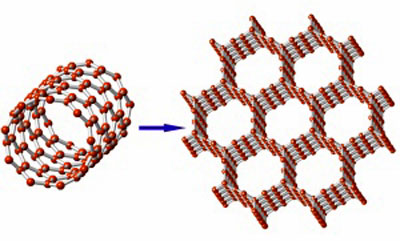|

05 December 2011
from
NatureAsia Website
Computer simulations predict new carbon
materials that are stiffer than carbon nanotubes and tougher than
diamond.

Bonding carbon
nanotubes (left) together into 3D arrays (right)
results in nanotube
polymer structures with remarkable mechanical and electronic
properties.
Carbon nanotubes are known for their
remarkable mechanical and electrical properties - but can these
properties be improved upon?
Calculations by Yongjun Tian and
colleagues from Yanshan University and Nankai University in China
have now shown that three-dimensional (3D) arrays of nanotubes could
have strikingly enhanced mechanical and electronic properties.1
Tian and his team used a computational approach to predict the
properties of the carbon-based materials that could be made if
arrays of carbon nanotubes could be bonded side-by-side to form a
three-dimensional polymer structure (above image). Their calculations
suggest that such materials should be quite possible to make, and
that they would have provide some important improvements to the nanotubes’ properties.
Of the eight structures predicted by the simulations, seven would be
‘superhard’ materials. Individual nanotubes are very stiff and
strong in the axial direction, but weak in the radial direction - a
factor that limits their application as structural materials.
However, the superhard 3D carbon
nanotube polymers are strong in both directions.
“Most of the nanotube polymers
combine this superhardness with good ductility, which gives them
the capability of resisting large strains without fracturing,”
says Tian. “They could be more resilient than diamond.”
In addition to the mechanical
enhancements, the 3D nanotube polymers also displayed some
surprising electronic characteristics.
Five of the polymers simulated only
conduct electrons along particular parallel and isolated one- and
two-dimensional channels due to the layout of the carbon-carbon
double bonds within the material.
“Another notable property is their
low density,” notes Tian. “These porous nanotube polymers have
potential uses as hydrogen-storage materials, shape-selective
catalysts, molecular sieves and absorbents.”
In order to tap into the properties of
these materials, the next step will be to make them.
Tian’s calculations predict that the
nanotube polymers should be more stable than carbon ‘buckyballs’,
and more stable than their parent nanotubes in some cases.
In fact, such structures have probably
been created before as unintended by-products in the synthesis of
other novel carbon materials, and simply never isolated.
“The next step is to explore
approaches to synthesize this class of 3D nanotube polymers,
including high-pressure polymerization and chemical reactions,”
says Tian.
Reference
-
Zhao, Z. S.1, Xu, B.1, Wang,
L.-M.1, Zhou, X.-F.2, He, J. L.1, Liu, Z. Y.1, Wang, H.-T.2
& Tian, Y. J.1 Three dimensional carbon-nanotube polymers.
ACS Nano 5, 7226 (2011). |
article
Author affiliation
1. State Key Laboratory of
Metastable Materials Science and Technology, Yanshan
University, Qinhuangdao 066004, China
2. School of Physics and Key Laboratory of Weak-Light
Nonlinear Photonics, Ministry of Education, Nankai
University, Tianjin 300071, China
|

